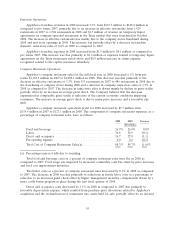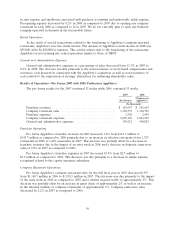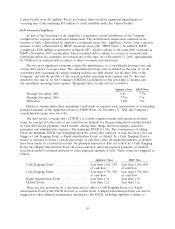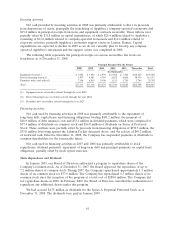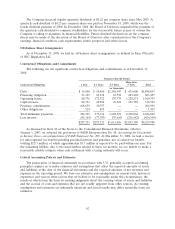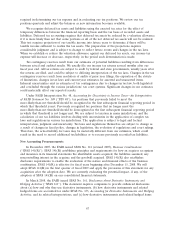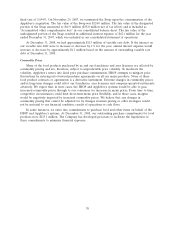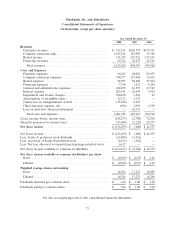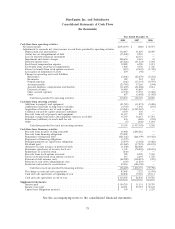IHOP 2008 Annual Report Download - page 79
Download and view the complete annual report
Please find page 79 of the 2008 IHOP annual report below. You can navigate through the pages in the report by either clicking on the pages listed below, or by using the keyword search tool below to find specific information within the annual report.period beginning upon our possession of the premises), and record the difference between the
minimum rents paid and the straight-line rent as a lease obligation. Certain leases contain provisions
that require additional rental payments based upon restaurant sales volume (‘‘contingent rent’’).
Contingent rentals are accrued each period as the liabilities are incurred, in addition to the straight-line
rent expense noted above.
Certain of our lease agreements contain tenant improvement allowances. For purposes of
recognizing incentives, we amortize the incentives over the shorter of the estimated useful life or lease
term. For tenant improvement allowances, we also record a deferred rent liability or an obligation in
our non-current liabilities on the consolidated balance sheets.
Management makes judgments regarding the probable term for each restaurant property lease,
which can impact the classification and accounting for a lease as capital or operating, the rent holiday
and/or escalations in payment that are taken into consideration when calculating straight-line rent and
the term over which leasehold improvements for each restaurant are amortized. These judgments may
produce materially different amounts of depreciation, amortization and rent expense than would be
reported if different assumed lease terms were used.
Insurance Reserves
We use estimates in the determination of the appropriate liabilities for general liability, workers’
compensation and health insurance. The estimated liability is established based upon historical claims
data and third-party actuarial estimates of settlement costs for incurred claims. Unanticipated changes
in these factors may require us to revise our estimates. We periodically reassess our assumptions and
judgments and make adjustments when significant facts and circumstances dictate. A change in any of
the above estimates could impact our consolidated statements of earnings, and the related asset or
liability recorded in our consolidated balance sheets would be adjusted accordingly. Historically, actual
results have not been materially different than the estimates that are described above.
Stock-Based Compensation
We account for stock-based compensation in accordance with SFAS No. 123 (revised 2004), Share-
Based Payment (‘‘SFAS 123(R)’’). Accordingly, we measure stock-based compensation expense at the
grant date, based on the fair value of the award, and recognize the expense over the employee’s
requisite service period using the straight-line method. Under SFAS 123(R), the fair value of each
employee stock option and restricted stock award is estimated on the date of grant using an option
pricing model that meets certain requirements. We currently use the Black-Scholes option pricing
model to estimate the fair value of our share-based compensation. The Black-Scholes model meets the
requirements of SFAS 123(R). The measurement of stock-based compensation expense is based on
several criteria including, but not limited to, the valuation model used and associated input factors,
such as expected term of the award, stock price volatility, risk free interest rate and forfeiture rate.
These inputs are subjective and are determined using management’s judgment. If differences arise
between the assumptions used in determining stock-based compensation expense and the actual factors
which become known over time, we may change the input factors used in determining future stock-
based compensation expense. Any such changes could materially impact our operations in the period in
which the changes are made and in subsequent periods.
Derivative Financial Instruments
In the normal course of business we utilize derivative instruments to manage our exposure to
interest rate risks. We account for our derivative instruments under SFAS No. 133, Accounting for
Derivative Instruments and Hedging Activities, as amended by SFAS No. 138, Accounting for Certain
Derivative Instruments and Certain Hedging Activities-an amendment of FASB Statement No. 133 and
65


